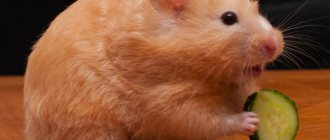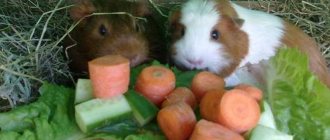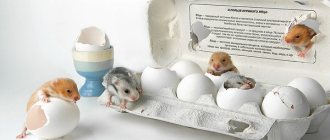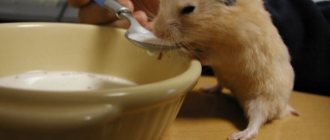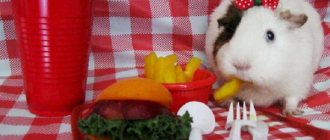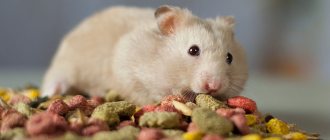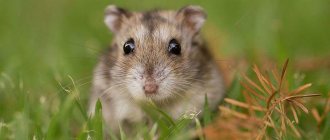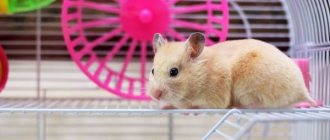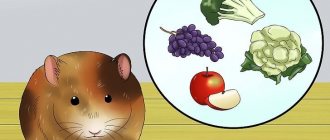Hamsters have a different digestive system than humans, and therefore most foods consumed by humans are not suitable for the delicate gastrointestinal tract of a domestic rodent. Some inexperienced hamster breeders feed their pets vegetables and fruits from the prohibited list, and then look for answers to the question of why the hamster died. To avoid having to look for an answer, you need to carefully monitor your hamster’s diet and include in its diet, in addition to grain food, various vegetables and fruits. One piece of an inappropriate or spoiled vegetable or fruit will be enough for a rodent to start having problems with the digestive system, and systematic feeding of such products is fatal. Today we will talk about a fairly common vegetable in our region and find out whether hamsters can have beets, boiled or raw.
Can hamsters eat beets?
The root vegetable contains many useful microelements. Feed rodents with caution. Try giving your baby a tiny piece of this vegetable and see his reaction. If everything is fine with his stool, you can give him a larger piece.
Do not overuse the size of the slice - it should be no larger than a button. If you overdo it, your pet will develop diarrhea, and small animals do not tolerate gastrointestinal diseases well.
What is needed to keep an animal at home?
Of course, thinking through the diet is half the battle to maintain your pet’s health. What else should you always remember?
Before you get an animal, you need to worry about the size of the cage. To ensure a sense of comfort, the ideal area per individual should be at least 40x40 cm
The second point that you need to pay attention to is the depth of the tray so that food and bedding (sawdust or hay) do not spill out. The entire structure must be made of metal rods
To create comfort, the room temperature should not exceed 18 degrees. Do not place the cage in a draft or near a radiator. Pigs must be allowed to walk around the apartment; with a sedentary lifestyle, they grow long claws, which over time grow into the pads, causing severe pain.
Guinea pigs have a well-developed sense of smell, as well as hearing, so in order not to create a stressful situation, do not play very loud music, and during repair work, take the cage with your pets to another room.
We hope you found this article helpful and learned a lot to help you keep your pet healthy!
Which beets are best to give?
The root vegetable retains its beneficial properties even with heat treatment, and can also be stored for a long time, which is very good in winter, when choosing quality fruits and vegetables can be difficult. But what is best for hamsters? Let's figure it out.
Raw beets
This vegetable can definitely be fed to an animal. It is worth choosing a small root vegetable, not too soft and without rotten places on it. Ideally, the vegetable grew in your garden.
If this is not possible, then buy the product from trusted people who grow with natural fertilizers without any chemicals. Remember that after eating something of poor quality once, the hamster may die.
Boiled beets
Hamsters can also use it in this form. But it is worth considering the peculiarities of preparation.
- Before serving, wash the vegetable well.
- Cook for a short time so that it does not lose its beneficial properties.
- You cannot add salt to the water or add spices and spices. It seems to us that it will taste better this way, but it will only make things worse for the baby.
- The peel must be cut off.
- The slice should not exceed 1 cm in size.
- You should not give this treat too often. Several times a week will be enough.
Which variety is best to give?
There are different types:
- Stern;
- Dining room;
- Sugar.
Most often we can find table beets because we often eat them ourselves. This vegetable can be given to your pet; it contains more beneficial microelements than other varieties.
Fodder - they feed pigs and cows on some farms, but your baby may also like this vegetable. It does not contain any particularly beneficial properties for the hamster.
Sugar beets can also be included in the diet, but be careful not to cause diabetes.
Features of feeding different breeds
Djungarian and Roborovsky hamsters are small. Accordingly, their feeding will be different: portions are smaller than for larger breeds, caution increases. The body of dwarf hamsters is even weaker than that of larger hamsters.
They are prone to diabetes, so sugar beets are contraindicated both raw and boiled. The baby can easily eat other varieties of this vegetable, however, the portion of the root vegetable should not be larger than the nail on the little finger. Just like other hamsters, dwarf hamsters should not be given this treat often. 1-2 times a week will be enough.
Syrian hamsters are larger in size. Not much, but still. These rodents can be given any variety of beets. But don't forget that everything is good in moderation. It is very important not to overfeed your hamster with beets - they have a laxative effect, which can cause diarrhea.
If you have your own garden, you can even please your pet with beet tops. You need to wash it well first so that there is no dirt left on it. However, caution must be exercised here as it is unknown how the hamster’s body will react to this. Give some tops and watch. If the pet likes it and everything is in order with health, then you can safely feed the tops as a variety of diet.
Pregnant hamsters should be given beets once a week, no more. It is better to exclude the sugar variety, because it can adversely affect the development of the fetus.
Choosing dry food
About 90% of the Djungarian hamster's diet consists of dry food, so you should be extremely responsible when choosing it. Breeders pay special attention to the composition of the mixture and the quality of packaging (it must be airtight). The presence of preservatives, dyes, and foreign inclusions in the composition is unacceptable. All grains must be intact, without signs of spoilage or mold.
The chosen food is not always to the hamster’s taste. Individuals are quite picky, so finding the perfect option can be difficult. There is no point in waiting until the animal gets hungry and starts eating the food offered: due to increased metabolism, a lack of nutrients for several days can cause health problems.
Most manufacturers indicate on the packaging the daily food intake for animals of different ages. If it is not indicated, you can focus on ¾ of the hamster’s weight. It is unacceptable to use mixtures intended for other animals to feed Djungarian hamsters.
They may contain products that pose a mortal danger to the body of jungarians. The content of nutrients in food, their composition and ratio can differ significantly, which in most cases negatively affects the health of the animals.
Food for dwarfs
Versele-Laga "Prestige Mini Hamster Nature"
One of the leading positions in the rating of dry food intended for Djungarian hamsters. It is distinguished by the inclusion of a variety of ingredients that allow you to make your diet extremely varied. The mixture is enriched with a full complex of vitamins, dried vegetables, and animal protein. Only seeds and grains should be used as an additive to dry food.
Chika-Bio "Food for Djungarian hamsters"
The composition was developed by the manufacturer taking into account all the characteristics of the dzhungarik’s body. It contains only natural ingredients. It contains vitamins, minerals, meat granules. The mixture includes small birch branches. To improve the condition of the coat, the mixture contains vitamins A and E.
Irina Ivanishchena
I am engaged in professional breeding of hamsters and rats on an ongoing basis. I know something about them that most people don’t know. Always open to constructive discussion
Post Views: 1,311
The benefits and harms of beets for a hamster
The vegetable contains many benefits. It will improve your pet’s digestion and improve its microflora balance. But it is worth remembering that you should not give too many treats to your hamster, as beets are weakening and their excessive consumption can cause diarrhea.
- Try to avoid low-quality products in your food.
- If your pet begins to feel unwell and is inactive, then seek help from a veterinarian. Perhaps he has an allergy to the root vegetable.
- The bowl should be washed after each meal of the animal.
- Uneaten remains of beets and other natural treats should be thrown away immediately if the pet no longer touches them. A spoiled product is also dangerous for the hamster.
Beets are a necessary and healthy root vegetable in the diet of hamsters, but in everything you should know when to stop. Don't be afraid to please your pet with a tasty and healthy treat.
Don't know what to feed your pet hamsters? Then you've come to the right place! Now you will find out which foods should be present in a hamster’s diet every day (Angora, Syrian, Djungarian), and which are not only undesirable, but also dangerous.
- Suitable Products
- Nuts and grains
- Vegetables, fruits and berries
- Protein food
- How many times a day to feed
- What to give him to drink
Is it possible to give melon?
Melon is a very useful product for humans, but the body of rodents is a little different. High sugar content is harmful to small animals, especially toy breeds, which are prone to developing diabetes.
Among other things, this crop sold on store shelves is always grown using chemical fertilizers, which are absorbed into the peel and penetrate directly into the pulp. For a person, such a concentration is completely harmless, but for a hamster, large doses of melon can be fatal or cause very severe digestive upset, vomiting, constipation or diarrhea.
If you really want to please your pet, you can give your Djungarian hamster dried melon. The piece must be very small or mixed with other delicacies. It is advisable to include raw melon seeds in the menu.
Suitable Products
A pet hamster can be fed only natural products. This is not the case when any food from our table can become complete nutrition for a pet. The digestion of rodents is quite delicate, and if you feed them the wrong foods, the animal can get sick.
Nuts and grains
A hamster needs solid food to wear down its teeth, which grow throughout its life. To make your diet as varied as possible, you can purchase special food at any veterinary store, including the usual cereals and whole grains, or make a mix at home, the list of which includes:
- Rice;
- Buckwheat;
- Wheat grains;
- Cereals;
- Pearl barley;
- Corn grains.
It is advisable to give your hamster seeds (sunflower and pumpkin, most importantly not fried) and nuts. Walnuts must first be cracked - the hamster himself cannot cope with this task, but hazelnuts must be given whole. The hamster himself will gnaw a hole in it and take out the kernel: he will eat and sharpen his teeth.
Angora and Syrian hamsters are more unpretentious in food - food for large rodents is also suitable for them, but large grains and whole nuts are much more difficult to chew for dwarf hamsters. To grind down the teeth, give them crushed cereal and solid calcium in the form of a pebble, which you can buy at a veterinary store or pharmacy.
The following products should not be given to your hamster:
- Bread, crackers, cookies, pastries;
- Almonds and Brazil nuts;
- Seeds from fruits and berries.
Vegetables, fruits and berries
Hamsters need juicy food for proper digestion, so their diet should include fresh vegetables and fruits. These include:
- Potatoes, carrots, beets, sweet peppers, cucumbers, zucchini, tomatoes, pumpkin;
- Apples, pears, peaches, apricots, plums, quinces, melons;
- Strawberries, raspberries, blueberries, currants, blackberries.
As for vegetables, hamsters should not be fed cabbage - this can cause digestive problems, and any exotic berries and fruits are undesirable.
Protein food
Hamsters can also be fed fish, meat, hard-boiled eggs, and fermented milk products, but the food should not be, firstly, raw, and secondly, fatty. Protein food should be given to your hamster no more than twice a week. Fresh milk should not be given.
Possible negative consequences
If an animal has eaten beets and has a food allergy, the following reactions are possible:
- eye inflammation, lacrimation;
- sneezing, coughing and nasal discharge;
- impaired breathing;
- diarrhea, vomiting;
- the appearance of an itchy rash;
- dizziness.
Reference! The very first thing to do in case of food poisoning is to contact a veterinary clinic. Be sure to avoid further consumption of the allergen. If the symptoms are very strong, then before the doctor arrives, you can give the animal activated charcoal.
What to give him to drink
The hamster should be given water with settled, unboiled water. The ideal drinking bowl is one with a ball at the end of the tube: the hamster moves the ball with its tongue and drinks the water flowing out of the tube. Open drinking bowls are not clean for more than five minutes, so it is best to avoid them.
Let's talk about such a component of a pet's diet as vegetables. It is a misconception to believe that a hamster can do anything - his digestive tract does not digest a number of vegetable crops well, and some are deadly to him. Let's look into the details: what is useful for the animal and what is not.
- Root vegetables (potatoes, beets, carrots)
- Potato
- Beet
- Carrot
- Radish
- Turnip
- Cucumbers and tomatoes
- Cucumber
- Tomatoes and cherry tomatoes
- bell pepper
- Cabbage and its varieties
- Other vegetables
- Eggplant
- Pumpkin
- Zucchini
- Finally
Tasty alternative
Don't be upset if for some reason you can't provide your pet with carrots. As for vegetables, there is a complete variety for rodents! They can eat peppers, zucchini, eggplant, cucumbers, radishes, beans, pumpkin, squash, cauliflower, broccoli, radish, and corn. The list of permitted products can be very long, so it’s easier to concentrate on the dangerous ones.
It is not advisable to feed rodents white or red cabbage, potatoes, sorrel, and garlic. Also dangerous can be pits from food and any plants grown in environmentally polluted conditions, such as cities, near roads.
Root vegetables (potatoes, beets, carrots)
Some of them are necessary for the animal every day, others only occasionally. It is also important in what form the rodent receives this or that vegetable. The basic principle is the same as in human nutrition: the less heat treatment a product is subjected to, the more useful substances are preserved in it.
Potato
Veterinarians clearly agree that the vegetable is not recommended for a hamster due to its high starch content. In small quantities, you can occasionally pamper your pet with them - it is acceptable to offer him raw or boiled potatoes, but not fried ones.
Only young potatoes (not green) without pesticides and nitrates are useful for the animal.
Beet
This vegetable is not recommended, but it is occasionally given fresh or boiled to Syrian hamsters. The cube should be no larger than a button, and they start with even smaller sizes in order to track the reaction of the gastrointestinal tract. If tolerance is normal, the portion is increased.
Keep in mind that there are three types of beets - fodder, table and sugar; hamsters are given the second option. The first contains practically no useful substances for the rodent, and the third can lead to diabetes mellitus, especially in Djungarians.
Carrot
It is not only possible, but must be given to the hamster; it is an essential ingredient in the daily diet. A mug 1.5 cm thick is enough for one approach - no more is needed, otherwise the rodent will start making supplies that will quickly spoil.
The best option is to treat your hamster with raw carrots; sometimes it is permissible to diversify the menu with boiled carrots. In addition to vitamins A, C, K, it is rich in dietary fiber, which is beneficial for digestion, and potassium for the heart muscle.
It is recommended to pre-soak all store-bought vegetables in water, this helps remove nitrates and other chemicals from them. Hamsters are sensitive to them, and due to their small size they can be poisoned by even a small portion of vegetables that have absorbed harmful substances.
Sometimes you can put 1 tablespoon of carrot tops in the animal’s bowl - it contains 5 times more vitamins than the root vegetable. But not from a store-bought vegetable - its above-ground parts are often treated with pesticides against pests, which is fatal to the rodent. If it is not possible to treat your pet to greens from your dacha, it is better to buy parsley, celery or lettuce at the supermarket - they are safer for your pet.
Radish
Recommended in small portions 1-2 times a week. Give preference to country vegetables or vegetables grown in your own beds. They contain folic acid, which is especially important for pregnant females; they effectively cleanse the liver and normalize the flow of bile. Pectin cleanses the body of toxins, and its low calorie content makes radishes a dietary product.
The root vegetable is useful in all respects, especially for Syrians prone to arthritis - turnips contain substances that protect joints from inflammation. Helps with osteoporosis, serves as a source of potassium and calcium for bones.
Nutritional properties
The composition of the red root vegetable is rich in vitamins C, A, B-1, B-2, P and PP, as well as microelements such as phosphorus, iron, potassium and magnesium. These nutrients protect guinea pigs and support their immune system. The plant is enriched with fiber, which helps cleanse the pet's body of toxins, acting as a mild laxative. The dense dietary fiber contained in the root vegetable improves digestion and has a beneficial effect on the liver. Due to the high concentration of oxalic acid, it is recommended to control the rate of its consumption.
Cucumbers and tomatoes
Both vegetables are beneficial for hamsters, but there are nuances to their introduction into the diet.
Cucumber
Allowed fresh 1 time per day, daily intake – up to 50 grams. Store-bought cucumbers are peeled and pre-soaked. Give it to young animals up to 2 months with caution, observing the reaction of the still immature gastrointestinal tract.
Young cucumbers are 90% water, helping to cope with excess weight and normalize digestion. The minerals in them strengthen bones, teeth, B vitamins – the nervous system, but most importantly, they remove toxins and heavy metal salts.
Tomatoes and cherry tomatoes
Tomatoes are useful for digestion, respiratory function, cleansing blood vessels and capillaries. They protect the hamster from cancer due to the content of lycopene and antioxidants. Strengthen nerve fibers and have a beneficial effect on the hematopoietic organs. They contain a lot of iodine for the thyroid gland and magnesium for the heart. They are given fresh without peel 1-2 times a week; preference is given to tomatoes from your own plot, grown without the use of chemicals.
In Syrian hamsters, tomatoes can provoke or aggravate arthritis; it is better not to give these rodents tomatoes.
Cabbage and its varieties
Syrian hamsters are prohibited from introducing it into their diet - the structural features of the gastrointestinal tract do not allow them to digest cabbage fibers.
Djungarian and Roborovsky hamsters can be offered the following types during the season (from August to November) 2-3 times a week, 50 grams each:
- colored (fresh, boiled);
- Beijing (fresh);
- broccoli (fresh).
You can read more about the formation of the diet of Djungarians and Syrians in separate articles.
It is not recommended for hamsters to include white cabbage in the menu - it causes fermentation in the intestines. And red-headed varieties are strictly prohibited - death is possible due to bloating.
Other vegetables
Don't forget to supplement your pet's diet with other healthy vegetables. They will not be among the basic ones, but if consumed 1-2 times a week they will bring tangible benefits to his body.
Eggplant
Recommended for fresh consumption, it is usually alternated with other vegetables, offering the hamster no more than 50 grams at a time. When purchasing, avoid overripe fruits - eggplants are useful because they restore the water-mineral balance in the animal’s body; unripe and stale fruits are not suitable for this.
Pumpkin
Contains a lot of fiber, beta-carotene, good for the eyes, phosphorus, iron, potassium. Useful as a treat even for overweight animals and diabetics. But, unlike carrots, it is not suitable as a daily food.
Pumpkin should diversify the diet, and not become its basis; it is useful in fresh, stewed, boiled form. Be sure to have no peel - it is cut off in a thick layer.
When baking, pumpkin should not be seasoned with oil, spices or salt. This puts a lot of strain on the liver of a rodent, which in nature does not eat such things.
Zucchini
Zucchini cannot be the basis of the daily diet - veterinarians advise alternating it with other juicy vegetables: cucumbers, eggplants, pumpkin.
Zucchini and pumpkin seeds deserve special attention. This healthy treat will help the rodent cope with parasites, as it has anthelmintic properties.
